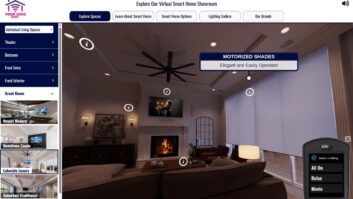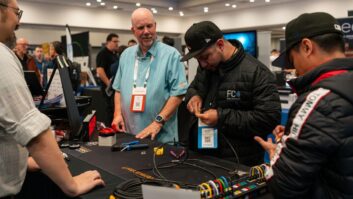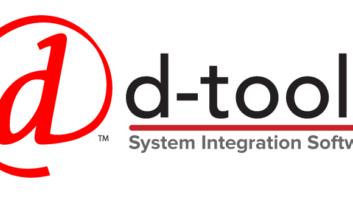TWICE:What specific multiroom-AV product segments have grown in popularity in recent years, and what’s on the horizon? What has or hasn’t lived up to expectations, and why?
Henderson: Putting aside for the moment the current economic issues, the custom trends have been very positive. A modern luxury home will count among its amenities a home theater, distributed audio, lighting control, and outdoor sound. iPods are routinely integrated, but an evolving and increasingly important alternative trend is streaming media, including subscription movie and music services and internet radio. The internet as a media channel is growing exponentially.
Baldwin: Media servers and iPod / iTunes integration are on the rise in our market in Houston. Consumers are expecting the features and benefits of integration, entertainment, and information to follow them, at home, in their car, while traveling.
Starkey: High-def video distribution, iPod attachment, IP control (local and remote), integration to lighting/climate/security, and more have all been significant drivers of growth for us and several companies. Anything attached or controlling an HDTV has seen phenomenal acceptance. Certainly anything that adds choice and content to the user environment will continue to be hot.
Hench: We’re seeing more distributed-video systems now, and as distributed audio systems have become more affordable, that segment is growing as well.
The dedicated server market has taken a hit. The multi-thousand-dollar server has been soundly displaced by the couple-of-hundred-dollar iPod dock. iPod docks have become the server of choice in a majority of installations. It is not unusual to see multiple iPod docks in a single home. Media Center PCs are another category that has not lived up to expectation.
Detmer: In recent years, content from popular digital sources such as iPod and satellite radio have driven the category, and wireless control with metadata feedback has put it over the top. On the horizon, look to more network-based content being distributed to remote clients streaming both audio and video with seamless control via in-wall panels to activate the system and two-way remotes to control it.
Soumbasakis: Whole-home automation is gaining in market share. Customers are expanding what once were multiroom-audio systems to control other subsystems in the home. The availability of products that have those capabilities has expanded significantly over the past few years. AVAD is having success selling solutions that support more home automation and control. To that end, we also just added Life|ware, which is Media Center-based, to expand the solutions we offer our customers.
Supran: We have seen integrators migrate a larger portion of their clients’ budgets to the categories in which they make the highest profit margin–like in-wall speakers. Products such as narrow-bezel or bezel-less installed speakers have reinvented an already very profitable category and made it even more compelling for dealers.
Dealers should be looking for ways to sell high-margin products for even higher price points, not lower. By introducing the variable of aesthetics into the sale of installed speakers, dealers can increase their average sale and provide their clients with great value. This more than anything has been the trend that we have started and plan to continue in the marketplace.
Baron: Built-in subwoofers have come from nowhere to become a reasonable option for consumers wanting truly stealth bass for their home theaters. Automation is going to grow not just because of the convenience but because of the green aspect as well. Of course, iPhone-type products with metadata are all the rage, but the natural progression is to tap into the music on the computer or server since all the music is already there.
The price of servers is a barrier except for the most exotic installations, so the tug will be to tap into the computer with storage getting ridiculously cheap. I’m hoping that lower cost multiroom electronics will emerge with less labor content so we can start attracting consumers with less than $1,000 per room (with labor) to spend. Whoever can crack this nut will be in a great position when the new housing market comes back, because we will attract consumers in the $250K-$500K range where real volumes can be done. You shouldn’t have to be wealthy to enjoy entertainment throughout your house.
Porritt: Mobile devices are going to have a profound effect on the multizone market. The iPhone is just the beginning – with so many advanced products on the way, more consumers will turn to them for everything short of cooking! They’re on all the time, store digital content, and offer very real opportunities for retrofit systems down the line.
TWICE:Is distribution of audio and video overCAT5 and 6 cable occurring in a growing percentage of jobs?
Baldwin: Absolutely. Most of our systems today include some distribution of audio/ video over twisted pair. With the adoption of flat-panel displays and architectural speakers, most rooms today have a display device, speakers, and some user interface, while the source components are centrally located. Manufacturers are answering the call for more distributed systems.
Starkey: While CAT5/6 systems are more prevalent today, the low-end fallout of the market has hurts its rise. Even with copper prices skyrocketing the past year, this has not been a sufficient driver alone to change the world from traditional wiring methods.
Hench: I wouldn’t call it commonplace just yet, but we are seeing a lot more distributed audio and video over CAT5 and 6. The difficulties of making reliable long runs of HDMI cable have helped fuel this market.
Detmer: Low-level signal distribution over CAT5 has increased tremendously. Typically, the ease of using balun transformers and routing signals over CAT5 outweighs using conventional cable for low -level signals.
Soumbasakis: Video distribution over CAT5 has been growing steadily. Installers are finding it easier and less expensive to run wiring to the display devices. It also gives them the flexibility to change the connectivity in the trim phase or, for that matter, in the future.
Porritt: A-BUS has made audio distribution over CAT5 a profitable and commonplace fixture of the multi-room market, and it won’t stop there. We’ll soon see HDMI over a single CAT5. The market is hungry for it so development is on the fast track.
TWICE:Are HD Radio, satellite radio, Internet radio, music-laden networked PCs, and iPods taking off as new music sources in custom systems?
Henderson: Absolutely, particularly in the case of streaming media sources. We are moving to a world where “local storage” and “physical” media will give way to hosted media. There will always be collectors of physical media— this market won’t go away any time soon—but having immediate access to literally millions of songs and thousands of movies is immensely appealing. The consumer is still somewhat in the dark about these products, but it’s only a matter of time before they dominate the market.
Starkey: Herein lies the great potential: more choice, more content and users want it at their fingertips. All these will continue to grow.
Hench: Satellite radio receivers are often included in the sale of distributed-audio systems, and a fair amount of XM / Sirius tuners are added to AV receivers. It is a nice business and growing, but I wouldn’t say it is taking off in a big way. Possibly the consolidation of XM and Sirius will help.
HD Radio is very neat, but its awareness level is still very low. The ads that ran earlier this year (2008) helped, but since then, we haven’t seen much activity (as of November 2008). I believe that will slowly change as more cars offer HD radio capability.
Detmer: These digital sources are growing in popularity compared to CDs and DVDs. However, customers still use cable boxes and satellite receivers to access favorite music channels offered by their service providers.
Soumbasakis: Virtually every system has some type of iPod docking, either from the receiver manufacturer or an in-wall model. Consumers are recognizing the benefits of subscription radio service such as Sirius/XM, and we are attaching them to many multiroom jobs.
Porritt: Personally, I love the idea of Internet radio, but adoption has been slow because it is a PC-based experience. Ultimately, we’ll see music-laden network PCs grow in popularity. If you need proof, just look at the latest iTunes numbers vs. traditional CDs. As consumers continue to gravitate to iPod-based listening, network storage will become a significantly bigger piece of the pie.
I think everyone is optimistic about the XM-Sirius???? merger, now that consumers will be able to buy programming a la carte, much like the cable TV model. It’s overdue and a step toward even greater interest in the profit potential of satellite radio.
TWICE:Are wireless technologies being installed in a greater percentage of jobs for home-system control?
Henderson:This certainly is a growth area for retrofit applications. Great strides have been made in terms of reliable operation, but I think the general feeling is still that hardwired systems are better.
Starkey: Wireless technology is finding its way into more and more homes. There are many choices of wireless technology, and users do not seem to care which is employed just that it works.
Hench: Yes, we’re seeing penetration of simpler, more affordable lighting control. Lighting control provides safety, convenience, and also has a green-technology benefit – all of which are important topics today. Remote control technology continues to evolve. Single remotes that control the entire home theater and more are becoming an essential part of more and more installations.
Detmer: Wireless control has increased significantly, primarily because of added reliability and the ability to see metadata feedback on the remote controller. Niles iRemote sales have increased significantly in the past year
Soumbasakis: Many of our remote control sales include RF extender options. This increases the range and reliability of the control device. For example, the Lutron RadiaRA is an RF-based light control system that is easy to retrofit and install in new construction applications.
TWICE:Are wireless technologies, including powerline and RF, going into a greater percentage of installs to distribute music around the house?
Henderson: Yes, for sure.
Hench: We think distributed audio over powerline has a place going forward. Although powerline technology is not new, the new distributed-audio systems that take advantage of it are, and the reaction from dealers has been extremely positive.
Detmer: We are seeing control via RF, but music is still distributed via cable.
Porritt: Yes, mostly because standards are being embraced, and interoperability between systems is much more reliable.
TWICE:Will wireless and other no-new-wires technologies have a positive or negative impact on the custom industry?
Henderson: Mostly negative. Clearly, these systems will eliminate much need for labor-intensive installations and are generally lower cost, so this will challenge dealers’ profit models. There will be “make it up in volume” opportunities, but this can only go so far. And these systems are tailor-made for mass marketers to add multiroom audio to their offerings, both on an install and DIY basis. The specialist needs to see this as another threat to his business and, again, focus on offering a qualitatively better system.
Starkey:The threat is probably more from do-it-yourself systems than from wireless per se.
Hench: Ultimately, I believe the impact on the custom industry will be positive. Although many basic systems are relatively easy for an end-user customer to set up, a specialist is still needed when integrating them with other products.
Soumbasakis: Any new technology has a positive impact as it increases the number of solutions available to the installer. The system still has to be designed to provide the solution that consumers are looking for and programmed in a manner that makes it easy to operate. So being able to avoid the run of wire is only part of the equation.
Porritt: Positive, of course. How could it not? PLC, for example, lets an installer complete a job in a fraction of the time of traditional installations, with a bare minimum of disruption to the customer’s lifestyle. A dealer who once pulled wires exclusively can now be positioned as a “home entertainment concierge,” thereby broadening his profile in the customer’s mindset.
TWICE:Are integrated systems being installed in a greater percentage of jobs than before?
Henderson: Greater.
Hench: The cost of reliable integrated systems has decreased, so they are now within reach of a much larger segment of the population, and we are seeing growth here in spite of the overall market’s decline.
Soumbasakis: Yes. More options and capabilities are being added all the time. They also are becoming easier to specify and program. The AVAD Integration Partner program is designed to make integration easier for the dealer. We get vendors to pre-engineer their products to work together seamlessly with a minimum amount of programming.
TWICE:Are lighting-control systems being installed in a greater percentage of jobs than before?
Henderson: Greater.
Starkey:As lighting systems have become more affordable, they are being attached at a higher rate.
Hench: Yes, the story is the same as with integrated systems. Lighting control is now affordable to a much larger customer base than before.
Soumbasakis: Lighting control is a rapidly expanding category. Dealers are finding it to be a new profit center that is easy to learn. Consumers are increasingly interested in making lighting part of their system, and when the lighting control integrates with the control system, it adds value to the entire sale. AVAD has also expanded its lighting-control options to include shading products from Lutron. We have implemented training session with Lutron to teach dealers how to sell, market, specify and install custom shade systems. They are motorized and can be easily integrated with Lutron lighting systems or the other whole home automation products we sell.
Porritt: Sure. Lighting controls are easier to install, simple to use, and offer the added benefit of being greener than standard lighting options.













